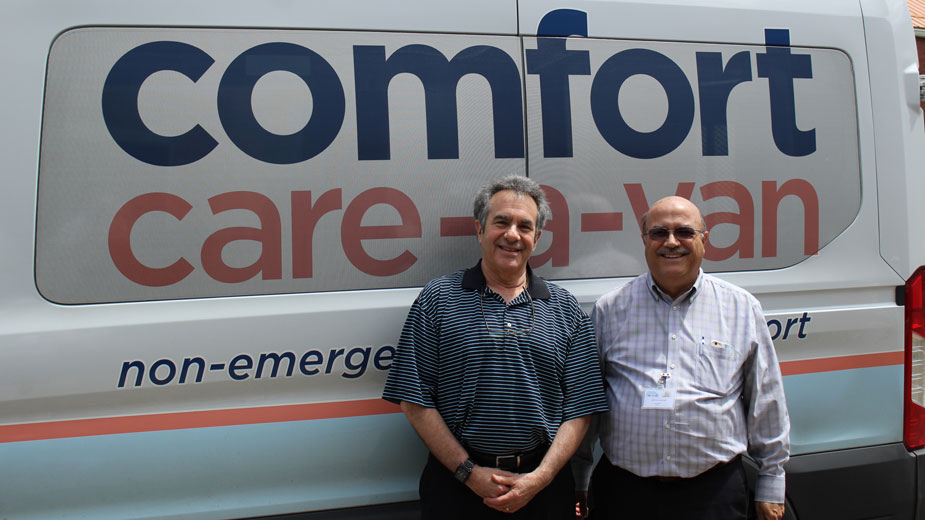‘Booming Business’ in Getting Seniors Where They Need to Go
YOUNGSTOWN, Ohio – For many years, transportation at Briarfield was contracted out, says CEO Diane Reese. But in the past few years, complaints started to come in, whether about the quality of the buses the contractor deployed or the ever-rotating roster of drivers.
“Continuity is important to our seniors. They build relationships with our drivers, especially those who have multiple appointments. They need to feel comfortable and safe with that person,” she says.
So, a year ago, the senior-care company purchased its own fleet of six vans and a few buses to get its residents to their medical appointments or even just into the community.
As the population of the Mahoning Valley ages, either in their own homes or in assisted living, getting them where they need to go is becoming more and more of a necessity.
“It’s something we take for granted, but for someone who’s difficult to transfer or has to be in a wheelchair, it’s difficult to get them places unless you have a van with a wheelchair lift,” Reese says. “It’s something that was lacking in our communities and lacking in our industry. That’s why we decided that we were going to invest in vehicles and drivers.”
Nationwide, non-emergency medical transportation, or NEMT in industry parlance, is a $12 billion industry that provides more than 1 million trips daily, according to NEMT Today magazine. Missed appointments, many of which are caused by insufficient transportation, cost the health-care field some $150 billion annually.
“It is absolutely a booming business. It’s going to grow because more and more people are living at home. Most of them probably aren’t going to be driving,” says Dave Mirkin, president and CEO of Mirkin & Associates, the parent company of Comfort Care-A-Van.
In Ohio, the boom started with then-Gov. John Kasich’s initiative to reduce the number of residents in senior-care facilities.
From the resident side, that meant more were able to age in their own homes, which many in senior care say is vastly preferred. And from Ohio’s perspective, it meant a big savings, as in-home care is much cheaper than a nursing home.
“With that transition from facilities to home care, it creates a huge need to get people where they need to be: medical appointments, treatments, dialysis, which right now is a huge thing,” Mirkin says. “Even minor things like visiting family or going shopping is all part of the necessity.”
Comfort Care-A-Van was started 2 1/2 years ago and has a fleet of 22 vehicles, half of which are wheelchair-accessible.
“They’re not treated like normal vehicles. Some have hydraulic lifts. It has a pulley system to pull [wheelchairs] back in. There are tracks that lock it in,” he continues. “It’s a lot different than what a consumer will have for their transportation. We have oxygen-tank holders, first-aid kits and a whole list of things.”
Also standing apart are the drivers. At Comfort Care-A-Van, all drivers have CPR and first-aid training, as well as safe-driving classes. Similar training is done for Briarfield drivers, Reese adds.
Such training is vital, Mirkin says, because while the service isn’t an ambulance, it is still involved in medical care. There have been cases where Care-A-Van drivers have stopped driving and had to call ambulances for patients, he adds.
Across the seven sites of Briarfield – five assisted living and two skilled-nursing centers – each has its own van, while buses are used for larger groups.
“It’s part of their care to get them back to an orthopedic surgeon or nephrologist or whatever their case may be. They need to be seen,” Reese says. “When transportation wasn’t reliable, that’s a reflection on our care. We immediately hired a driver and it’s worked out very well.”
Beyond just transit to doctor’s appointments, Briarfield also uses its fleet to take residents out into the community, such as group outings to White House Fruit Farm, and can provide trips to family events when needed.
“There are times when families want their loved one to come home for a holiday or just to do something with them like shopping or go to a restaurant,” Reese says. “They can’t always get them into a regular vehicle. If we’re able to coordinate, our driver is able to do that. It just enhances their quality of life.”
Whereas Briarfield offers transportation as an added service to its residents, Comfort Care-A-Van services can be covered by insurance providers, Mirkin says.
“We do everything from private pay to insurance companies to managed-care groups,” he says. “The managed-care groups also have companies that do their transportation because the groups focus on health care. They have transportation brokers, which is common in this industry.”
And through senior-service levies passed in Mahoning, Trumbull and Columbiana counties, local agencies can coordinate transportation for seniors, including companies such as Care-A-Van.
“We’ve been fortunate in this Valley with commissioners in the counties who see the necessity of taking care of seniors. Mahoning, Trumbull and Columbiana counties all have funding for senior care, including transportation,” Mirkin says. “We need to make sure those continue because the worst thing that can happen is there’s a program to bring people home and we don’t have the resources to provide the services they need.”
Pictured: Comfort Care-A-Van operates a fleet of 22 vehicles, say CEO Dave Mirkin and driver Urban Olmi.
Copyright 2024 The Business Journal, Youngstown, Ohio.



